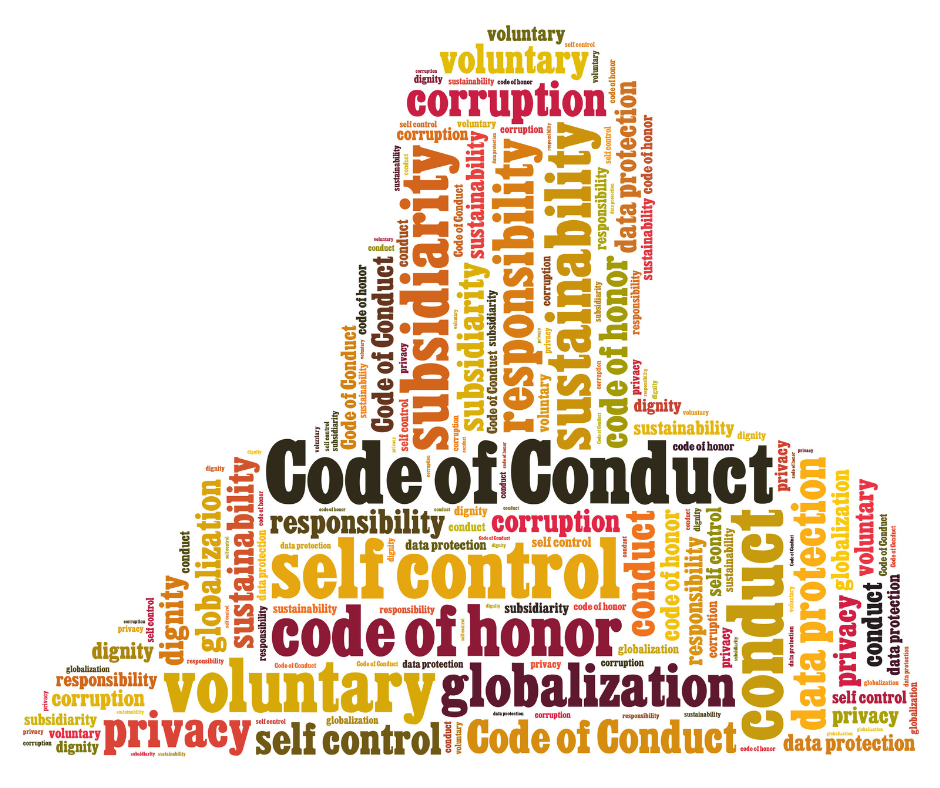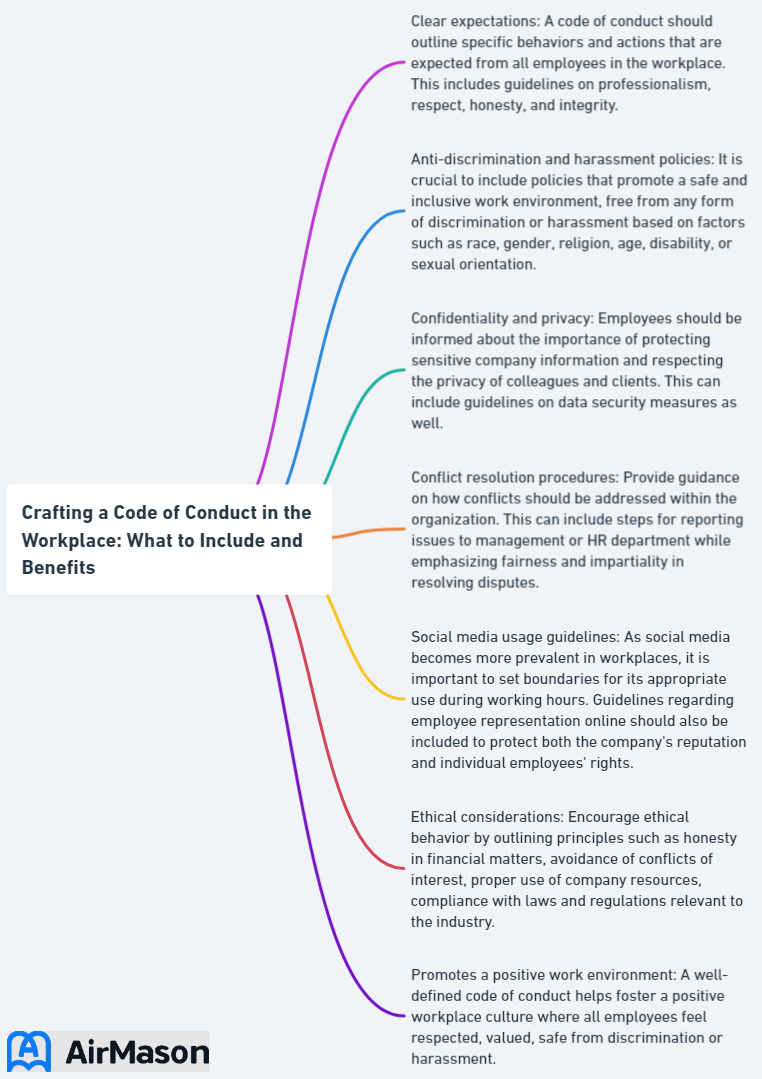
In today’s fast-paced, ever-changing business environment, a well-crafted “code of conduct in the workplace” is more than just a set of rules; it has become a cornerstone of an organization’s identity. But how can companies ensure their code of conduct is comprehensive, effective, and reflective of their unique values and culture? By examining the examples of successful organizations, we can gain valuable insights and inspiration for crafting our own code of conduct in the workplace. This blog post will guide you through the essential components of a code of conduct, implementation strategies, and lessons learned from leading companies.
Key Takeaways
- A code of conduct in the workplace is essential for setting standards, guiding decisions and reinforcing organizational culture.
- It should reflect an organization’s values, promote ethical decision-making and provide clear guidance on expected employee behavior.
- Successful companies have implemented comprehensive codes of conduct to protect their company assets and resources.
The Importance of a Code of Conduct in the Workplace
A well-designed code of conduct serves as a compass, guiding employees’ actions and decisions, while also providing a foundation for a healthy work environment. By clearly outlining company values, ethical business conduct, and behavioral expectations, the code of conduct reinforces the company culture and ensures that all employees are on the same page. This, in turn, helps organizations to comply with laws and regulations, while boosting employee morale.
Moreover, having a code of conduct in place sends a strong signal to external stakeholders, such as clients, investors, and partners, that the company takes its ethical obligations seriously. This can enhance the organization’s reputation and credibility in the marketplace, ultimately contributing to its long-term success.

Defining Company Values and Ethics
A successful code of conduct should:
- Reflect the organization’s values
- Promote ethical decision-making
- Align with the company’s vision and mission
- Provide clear guidance on expected employee behavior.
The forthcoming sections will explore methods for aligning the code of conduct with the company vision and promoting ethical decision-making.
Aligning with Company Vision
One of the key elements of an effective code of conduct is its alignment with the organization’s vision and goals. This ensures that employees understand the company’s purpose and direction, while also fostering a sense of unity and commitment to a common cause. To achieve this alignment, the code of conduct should incorporate the company’s mission, values, and core beliefs, relating the desired behavior and practices to the overall goals and objectives of the company.
The code of conduct, also known as the company’s code, serves as a valuable tool to strengthen company culture and align employees with the company’s vision. This can be achieved through continuous communication, training, and reinforcement, ensuring that the code of conduct remains a living document that evolves along with the organization.
Promoting Ethical Decision-Making
Ethical decision-making plays a crucial role in fostering a culture of honesty and accountability within an organization. By providing a framework for ethical decision-making, a code of conduct can help employees make choices that align with the organization’s values and ethical standards. To achieve this, the code of conduct should outline key principles, such as:
- Transparency
- Responsibility
- Empathy
- Fairness
- Integrity
- Respect
- Compassion
- Courage
- Wisdom
These core values serve as a guide for individuals in making ethical choices and establishing an ethical culture within the organization.
Fostering open communication and equipping employees with necessary guidance and resources can effectively promote ethical decision-making. This can be achieved through regular training, access to additional resources, and support from leadership and human resources.
Establishing Employee Behavior Expectations

A comprehensive employee code, also known as a code of conduct, should clearly outline employee behavior expectations. This includes areas such as social media usage, conflict resolution, and professional conduct.
The next sections will delve into these aspects and offer guidance on establishing clear expectations for employee behavior.
Social Media and Online Presence
In the digital age, an organization’s image and reputation are significantly shaped by social media and online presence. As such, it is crucial to include guidelines for employees’ online presence in the code of conduct. This can involve:
- Setting expectations for appropriate social media usage, both during and outside working hours
- Providing guidance on the use of company-related content
- Ensuring respectful communication
By incorporating these guidelines, the code of conduct helps to ensure that employees maintain a professional online presence that reflects the organization’s values and ethos. This, in turn, can contribute to a positive brand image and foster a sense of trust and credibility among external stakeholders.
Conflict Resolution
Conflicts are inevitable in any workplace, and it is important for a code of conduct to provide guidance on how to handle and resolve them. This can be achieved by outlining procedures for conflict resolution, such as identifying the source of the conflict, understanding the interests of all parties involved, and finding a mutually satisfactory solution.
By including such procedures in the code of conduct, organizations can promote a collaborative and respectful work environment, where employees feel empowered to address conflicts in a constructive and respectful manner. This can lead to improved teamwork, productivity, and overall employee satisfaction.
Internal and External Practices

In addition to employee behavior expectations, a code of conduct should also cover both internal policies and procedures, as well as external relationships and interactions. This ensures that company employees are aware of their responsibilities not only within the organization but also in their dealings with clients, customers, and other stakeholders, including the proper use and management of company property.
Let’s explore these aspects in more detail in the following subsections.
Internal Policies and Procedures
Internal policies and procedures, also known as company policies, serve as the backbone of an organization’s day-to-day operations, and it is vital to include them in the code of conduct. These policies may encompass areas such as attendance, dress code, and paid time off, ensuring that employees understand their responsibilities within the organization and are held accountable for their actions.
By outlining these internal practices in the code of conduct, organizations can foster a sense of consistency and uniformity in their processes, ultimately contributing to a more efficient and productive work environment.
External Relationships and Interactions
An organization’s success is often heavily influenced by its relationships with external or internal party members, such as clients, customers, and stakeholders. As such, it is essential to include guidelines for professional and appropriate interactions with these parties in the code of conduct. This can involve addressing areas such as client confidentiality, respectful communication, and adherence to relevant laws and regulations.
By incorporating these guidelines, the code of conduct helps to ensure that employees maintain a high standard of professionalism in their dealings with external parties. This, in turn, can contribute to improved customer satisfaction, stronger business partnerships, and a positive reputation in the marketplace.
Addressing Misconduct and Disciplinary Actions

A truly effective code of conduct requires clear definitions of misconduct and outlines of potential disciplinary actions for violations. This ensures that employees understand the consequences of their actions and are held accountable for any breaches of the code of conduct.
By addressing misconduct and disciplinary actions in the code of conduct, organizations can create a sense of fairness and transparency, fostering a culture of integrity and responsibility. This can ultimately lead to increased employee morale, improved workplace relationships, and a more harmonious work environment.
Implementing and Enforcing the Code of Conduct

Successful implementation and enforcement of a code of conduct require effective communication, training, and robust reporting mechanisms to address issues such as misuse company equipment.
The subsequent sections will discuss strategies for effective communication of the code of conduct, provision of ongoing training, and establishment of reporting mechanisms for violations.
Communication and Training
Effective communication is a crucial aspect of implementing and enforcing a code of conduct. This involves:
- Disseminating the code to all employees through onboarding, training, and ongoing reinforcement
- Ensuring that everyone is familiar with the organization’s values and expectations
- Regular training sessions to keep the code of conduct fresh in employees’ minds and provide them with necessary guidance to navigate complex situations.
In addition to training, it is essential to maintain open lines of communication between employees and management, providing a platform for employees to voice their concerns, ask questions, and seek clarification. This creates a supportive environment where employees feel empowered to make ethical decisions and adhere to the organization’s values.
Reporting Violations and Maintaining Confidentiality
Establishing clear channels for reporting violations is a crucial component of an effective code of conduct. Providing employees with the opportunity to report violations confidentially and anonymously helps ensure a safe reporting environment and protects whistleblowers from potential retaliation. The reports are typically managed by a designated team or department responsible for examining and addressing the reported violations.
In addition to anonymous reporting options, it is essential to emphasize the importance of maintaining confidentiality in the code of conduct. This helps to protect the privacy of employees and fosters trust in the organization’s commitment to ethical behavior.
Code of Conduct Examples from Successful Companies

Valuable insights into the key components of an effective code of conduct and best practices can be gained by examining examples from successful companies like General Motors, L’Oreal, and Sony. These organizations have successfully implemented comprehensive codes of conduct that reflect their unique values, culture, and business practices, ultimately contributing to the protection and growth of their company assets and efficient utilization of company resources for long-term success. It is important to note that these insights are applicable to other businesses as well, even if they are not the company being examined.
Drawing inspiration from these examples, organizations can tailor their code of conduct to fit their specific needs and create an environment where employees are empowered to make ethical decisions and contribute to the company’s overall success and growth, recognizing that each company operates differently.
Summary
In conclusion, crafting an effective code of conduct is a critical component of creating an ethical work environment that fosters a culture of integrity, responsibility, and trust. By aligning the code of conduct with the company’s vision and values, establishing clear expectations for employee behavior, and providing effective communication and training, organizations can ensure that their employees adhere to the highest ethical standards and contribute to the company’s long-term success.
As we have seen from the examples of successful companies, the code of conduct serves as a cornerstone of an organization’s identity and culture. By learning from their best practices and tailoring the code of conduct to fit the unique needs of your organization, you can create an environment where employees are empowered to make ethical decisions, foster positive relationships with external stakeholders, and contribute to the company’s overall growth and success.
Frequently Asked Questions
What are the 5 codes of conduct?
The five codes of ethics are Integrity, Objectivity, Professional competence and due care, Confidentiality, and Professional behaviour. These principles provide a foundation for ethical conduct, creating a framework in which accountants work in a fair and honest manner.
What are the three basic codes of conduct?
The three basic codes of conduct are a compliance-based code of ethics, a value-based code of ethics, and a code of ethics among professionals.
What is the purpose of a code of conduct in the workplace?
A code of conduct is essential to create a positive work environment, guide employee behavior, meet legal obligations, and boost employee morale while encouraging ethical practices.
How can a company ensure their code of conduct is in line with company vision and goals?
A company can ensure their code of conduct is in line with company vision and goals by incorporating their mission, values, and core beliefs into it, linking desired behaviors to the organization’s overall objectives.
What are the key principles to promote ethical decision-making in an organization?
Transparency, responsibility, empathy, fairness, integrity, respect, compassion, courage, and wisdom are key principles to promote ethical decision-making in an organization.